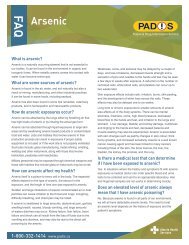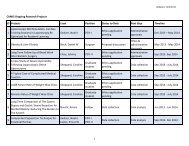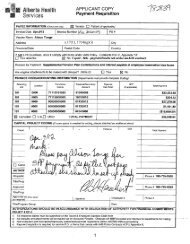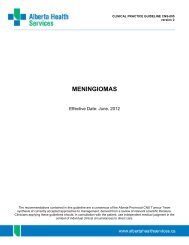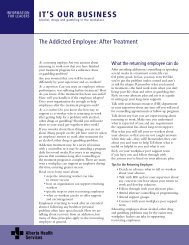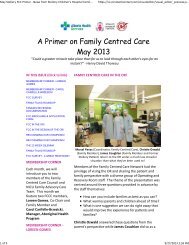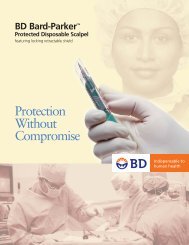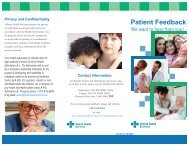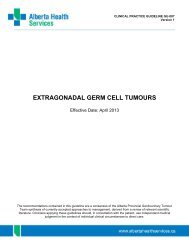Lab Values - Alberta Health Services
Lab Values - Alberta Health Services
Lab Values - Alberta Health Services
You also want an ePaper? Increase the reach of your titles
YUMPU automatically turns print PDFs into web optimized ePapers that Google loves.
AMNSP Day #2<br />
Haemoglobin<br />
o Normal –Female 120‐160<br />
o Normal –Male 137‐180<br />
o When do you get concerned?<br />
Haemoglobin<br />
Conditions to expect lower than normal value:<br />
o Anaemia (various types)<br />
o Erythropoietin deficiency (from kidney disease)<br />
o Red blood cell destruction or bleeding<br />
o Lead poisoning<br />
o Malnutrition<br />
o Nutritional deficiencies of iron, folate, vitamin B‐<br />
12, vitamin B‐6<br />
o Over hydration<br />
I have a result…Now so what?<br />
o Questions to ask yourself:<br />
• Is it a known/expected value?<br />
• Will the current course of treatment correct the<br />
issue?<br />
• Is the critical value consistent with the disease<br />
process going on in the patient?<br />
o If the answer is YES:<br />
• Don’t get excited, remain calm<br />
• Follow the trends<br />
Haemoglobin<br />
o What else should you consider:<br />
CBC<br />
• Hematocrit (Hct)<br />
• Normal 0.40‐0.54 L/L<br />
• The volume of RBCs packed in a 100 mL of<br />
blood as a percentage<br />
• Platelets<br />
• Normal 150‐400 x 10E9/L<br />
• Low count =<br />
• High count =<br />
2011-09-29<br />
1
White Blood Cells<br />
High numbers of WBC’s (leukocytosis) may<br />
indicate:<br />
• Infectious disease<br />
• Inflammatory disease<br />
• Leukemia<br />
• Severe emotional or physical stress<br />
WBCs<br />
• WBCs:<br />
Normal: 4.0‐11.0 x10 E9/L<br />
ASA, heparin, epinephrine, digitalis, and lithium can increase WBCs<br />
• Neutrophils:<br />
Normal: 2.0‐8.0 10 E9/L<br />
First responders<br />
• Lymphocytes:<br />
Normal: 0.7‐3.5 10 E9/L<br />
Increase in viral infections<br />
• Monocytes:<br />
normal: 0.0‐1.0 10 E9/L<br />
Second responders<br />
Blood Cultures<br />
o When should blood cultures be drawn?<br />
o Is there anything different to be aware of?<br />
o Do these need to be reported immediately or can<br />
it wait?<br />
o What if the patient is already on antibiotics?<br />
White Blood Cells<br />
Low numbers of WBC’s (leukopenia) may<br />
indicate:<br />
• Bone Marrow Failure<br />
• PPresence of f cytotoxic t t i substance bt<br />
• Disease of the liver or spleen<br />
• Radiation<br />
• Eosinophils:<br />
normal: 0.0‐0.7 10 E9/L<br />
Increase in an allergic reaction<br />
• Basophils:<br />
normal: 0.0‐0.2 10 E9/L<br />
Increase during healing<br />
• Bands:<br />
WBCs<br />
Electrolytes<br />
• Sodium (Na+):<br />
Normal 135‐145 mmol/L<br />
It has a water retaining effect helping maintain<br />
body fluids<br />
Also responsible for neuromuscular impulses<br />
via the sodium channel pump<br />
2011-09-29<br />
2
Hyponatremia: Na < 135mEq/L<br />
Symptoms include:<br />
• Dysphagia<br />
• Facial weakness<br />
• Muscle weakness (pronounced)<br />
• CComa<br />
Risk Factors:<br />
• Alcoholism<br />
• General illness<br />
• Malnutrition<br />
• Significantly sodium restricted diets<br />
Potassium<br />
• Potassium<br />
• Normal 3.5‐5.0 mmol/L<br />
• Influenced by:<br />
• insulin –stimulates cellular uptake of K+<br />
• Epinephrine – stimulates cellular uptake of K+<br />
• Plays many different roles in the body including affecting<br />
cardiac muscle contractility and transmission of nerve<br />
impulses<br />
• Death can occur if levels are 7.0 mmol/L<br />
• The body does not conserve K+ it excretes approx.<br />
40mEq/L/day<br />
Hypokalemia: K+ < 3.5<br />
• Treatment:<br />
• Replacement –oral or IV<br />
• IV rate should h ldbbe lless than h 10 mEq/hr /h unless l via i<br />
central line with cardiac monitoring<br />
Hyponatremia: Na < 135mEq/L<br />
Treatment:<br />
• Fluid restriction<br />
• Diuretics<br />
• Hypertonic infusions ex: 3% Saline<br />
• Only actively replaced in symptomatic patients<br />
• Do not replace faster than 2 mEq/l/hr due to<br />
risk of Central Pontine Myelinolyis<br />
Hypokalemia: K+ < 3.5<br />
• Can be caused by:<br />
• Dietary deficiency<br />
• Excessive potassium loss because of a gastrointestinal<br />
disorder<br />
• Vomiting<br />
• Diuretic use<br />
• Renal artery stenosis<br />
• Hyperaldosteronism<br />
Hyperkalemia: K+ > 5.5<br />
Hyperkalemia can KILL!!!<br />
o Hyperkalemia can cause:<br />
Fl id l i th i<br />
• Flaccid paralysis, paresthesias<br />
• Irritability<br />
• Abdominal distention and diarrhoea<br />
• Potentially lethal cardiac dysrhythmias<br />
2011-09-29<br />
3
Hyperkalemia: K+ > 5.5<br />
• Acute treatment:<br />
• Calcium – stabilizes the cardiac membranes,<br />
improves ECG but does not affect K+ levels<br />
• Glucose and insulin<br />
• Sodium bicarbonate<br />
• Diuretics<br />
• Calcium exchange resins<br />
• Chloride:<br />
Electrolytes<br />
Normal 98‐111 mmol/L<br />
Plays an important role in water balance, osmolarity of<br />
fluids, and acid base balance<br />
Levels coincide with sodium and bicarbonate<br />
• Carbon Dioxide<br />
Normal 21‐31 mmol/L<br />
Used to determine acid base balance<br />
Can be used instead of bicarbonate level (HCO3) to<br />
determine acid base balance<br />
Creatinine Considerations:<br />
• Drugs that can increase creatinine measurements<br />
include:<br />
• Aminoglycosides (Gentamycin)<br />
• Bactrim<br />
• Cimetidine<br />
• Heavy metal chemotherapeutic agents (Cisplatin)<br />
• Nephotoxic drugs –such as cephalosporins<br />
• Monitor trending<br />
• Consider patients meds and condition<br />
Hyperkalemia: K+ > 5.5<br />
Chronic Treatment:<br />
• Aldosterone : It increases the re‐absorption of<br />
sodium and water along with the excretion of<br />
potassium p<br />
• Diuretics<br />
• Calcium exchange resins<br />
• Dialysis<br />
Creatinine<br />
Higher than normal levels may indicate:<br />
o Acute renal failure<br />
o Chronic renal failure<br />
o Dehydration<br />
o Shock<br />
o Congestive heart failure (reduced renal flow)<br />
o Rhabdomyolysis<br />
• Normal 2.10‐2.55<br />
Calcium Ca+<br />
2011-09-29<br />
4
Hypocalcaemia: Ca+ < 2.0<br />
Symptoms include:<br />
• Latent tetany‐muscle fatigue, weakness, numbness<br />
• Overt tetany – twitching and cramping of muscles,<br />
carpupedal spasms and seizures<br />
Treatment:<br />
• IV Calcium –gluconate or chloride<br />
• Consider medications –steroids increase calcium<br />
loss<br />
Hypercalcemia > 3<br />
Symptoms:<br />
• Renal – hypercalciuria, urinary calculi<br />
• Skeletal –bone pain, fractures, demineralization<br />
• GI – anorexia anorexia, weight loss loss, constipation, constipation pancreatitis<br />
• Neurological –emotional changes, abnormal mentation,<br />
obtundation, coma, fatigue, muscle weakness<br />
Magnesium: Mg<br />
• Normal: Mg 0.7‐1.2 mmol/L<br />
• Part of the production and transport of energy<br />
• Important in the contraction and relaxation of<br />
muscles<br />
• Synthesis of protein<br />
• Assists in the functioning of certain enzymes<br />
Hypercalcemia > 3<br />
Causes:<br />
• Bone mets<br />
• Hyperthyroidism<br />
• Thi Thiazide id diuretics di ti<br />
• Immobilization<br />
• Vitamin D intoxication<br />
Hypercalcemia > 3<br />
Treatment:<br />
• Emergent treatment –hydration, sodium diuresis<br />
• Phosphate<br />
• Calcitonin<br />
• Glucocorticoids<br />
• Increased fluid intake<br />
• Estrogen<br />
Hypomagnesium >0.7mmol/L<br />
o Symptoms include:<br />
• Irritability<br />
• Anorexia<br />
• Fatigue<br />
• Insomnia<br />
• Muscle Twitching<br />
o Rapid heartbeat and other arrhythmias can<br />
occur with moderate deficiencies<br />
2011-09-29<br />
5
Hypomagnesium >0.7mmol/L<br />
o Treatment:<br />
• Assess for signs and symptoms of weakness,<br />
irritability, tetany, ECG changes, delirium<br />
• Patients will be given Magnesium Sulphate IVPB,<br />
• Mild hypomagnesium patients will be given PO<br />
replacement<br />
References<br />
www.nlm.nih.gov/medlineplus<br />
www.emedicine.com<br />
www.calgarylabservices.com<br />
Eikenberry, L. Critical <strong>Lab</strong>s: What’s Important to<br />
Know<br />
Ficaccio, S.; Tuinenga, S. (2004). Common Surgical<br />
<strong>Lab</strong> <strong>Values</strong>.<br />
• ALT:<br />
• AST:<br />
• Bilirubin:<br />
• ALP:<br />
• GGT:<br />
Liver Function Tests<br />
2011-09-29<br />
6



